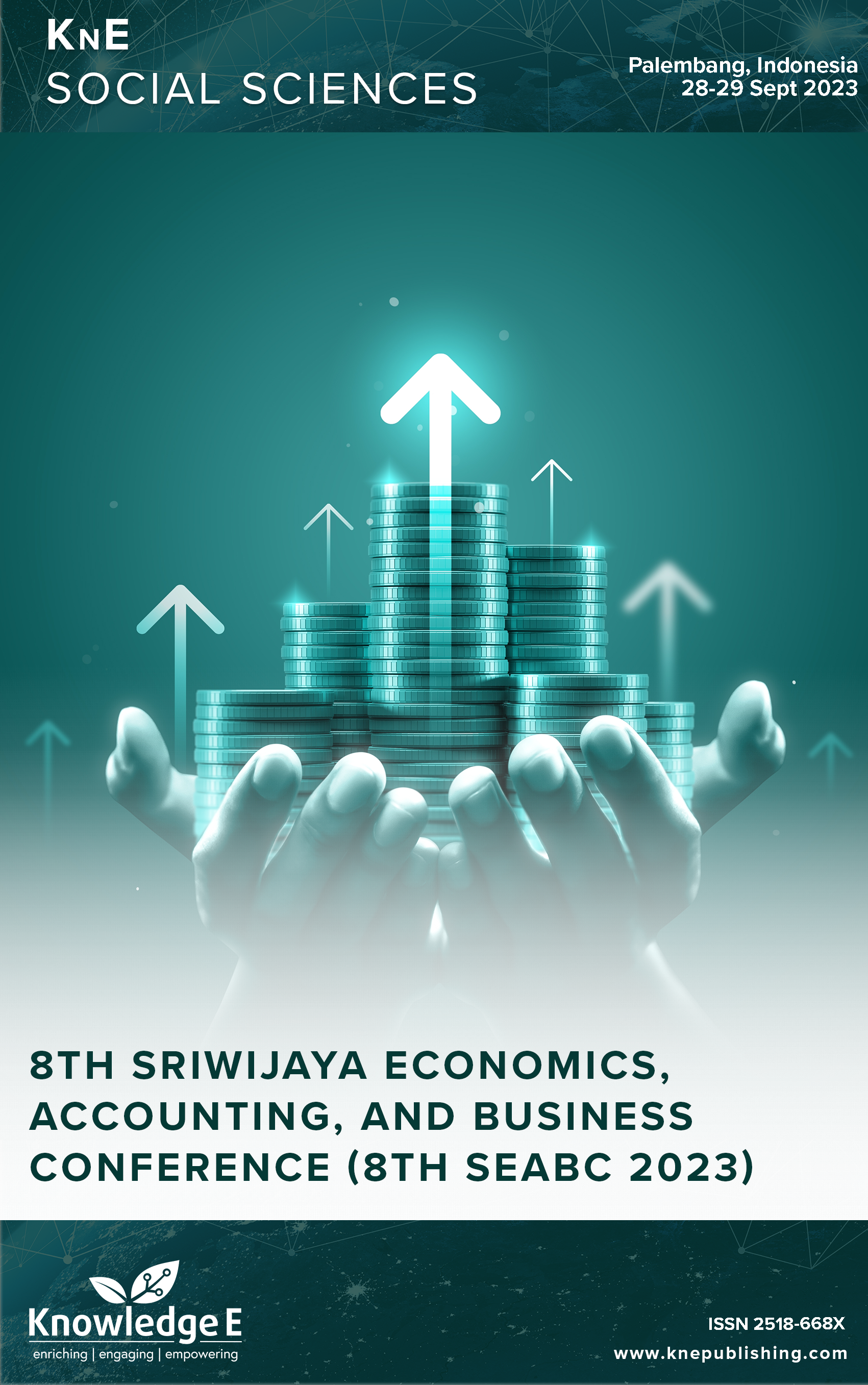Determinants of Production in the Bread and Cake Industry in Banyumas District
DOI:
https://doi.org/10.18502/kss.v9i14.16105Abstract
The industrial sector is a pertinent driving force for economic development in developing countries, including Indonesia. Therefore, the industrial sector more than other industries must be prepared to become a leading sector. One of the industrial sectors growing in the Banyumas district is the food industry, especially cakes and bread. This research aims to analyze the effect of capital, labor, and raw material on the production of the food items and identify the independent variables that influence the production the most. The population of this study is 108 bread and cake business units. The sampling technique used is Stratified Random Sampling based on the number of workers. The data analysis technique used is multiple linear regression which refers to the Cobb-Douglas production function using natural logarithms. The results show that capital, labor, and raw materials partially have a positive and significant effect on production; capital, labor, and raw materials simultaneously have a substantial impact on production; the most influential variable on production is the raw material. The research implies that the bakery industry in Banyumas Regency should use a combination of production factors such as capital, labor, and raw materials optimally to increase production. Furthermore, it is hoped that the Banyumas Regency Government and financial institutions can increase the ease of access to capital to support business development. To increase labor productivity, the government and companies can facilitate to improve their knowledge and skills.
Keywords: capital, labor, raw materials, production
References
Amin AA. Peranan Sektor Industri Pengolahan Terhadap Perekonomian Dan Penyerapan Tenaga Kerja di Provinsi Sulawesi Utara. Jurnal Sosial Ekonomi. 2015;6(8):1–23.
Indrawati T. Pengaruh Sektor Industri Pengolahan Terhadap Pertumbuhan Ekonomi Provinsi Kepulauan Bangka Belitung. Jurnal Ekonomi : Journal of Economic. 2021;12(1):104–108. DOI: https://doi.org/10.47007/jeko.v12i01.4086
Hasibuan JS. Analisis Kontribusi Sektor Industri Terhadap PDRB Kota Medan. Jurnal Ilmu Ekonomi Dan Studi Pembangunan. 2015;3(1):53–61.
Sugiarto HT. Brastoro SR, et al. Ekonomi Mikro. Jakarta: PT Gramedia Pustaka Utama; 2007.
Nicholson W, Snyder C, Christopher M. Microeconomic theory: Basic principles and extensions. 2016.
Sulistiawati R. Pengaruh Investasi terhadap Pertumbuhan Ekonomi dan Penyerapan Tenaga Kerja Serta Kesejahteraan Masyarakat di Provinsi di Indonesia. Jurnal Ekonomi Bisnis Dan Kewirausahaan. 2012;3(1):29–50.
Virnayanti PS, Darsana IB. Pengaruh Tenaga Kerja, Modal Dan Bahan Baku Terhadap Produksi Pengrajin Patung Kayu. E Journal EP Unud. 2018;7(11):2338–2367.
Joesron TS, Fathorrozi M. Teori Ekonomi Mikro. Jakarta: Salemba Empat; 2003.
Winarsih B. Bandi. Pengaruh Tenaga Kerja, Teknologi dan Modal dalam Meningkatkan Produksi di Industri Pengolahan Garam Kabupaten Pati. Jurnal Pendidikan Insan Mandiri. 2015;1(1):88–98.
Wibowo R. Pengaruh Modal, Tenaga Kerja, Bahan Baku, Mesin Terhadap Produksi Industri Kecil Konveksi Desa Padurenan Kecamatan Gebog Kabupaten Kudus. Economics Development Analysis Journal. 2012;1(2):42–50.
Andriani DN. Pengaruh modal, tenaga kerja, dan bahan baku terhadap hasil produksi (studi kasus pabrik sepatu PT. Kharisma Baru Indonesia). EQUILIBRIUM: Jurnal Ilmiah Ekonomi dan Pembelajarannya. 2017;5(2):151. DOI: https://doi.org/10.25273/equilibrium.v5i2.1543
Sutra R, Ananda F. Influence of capital, labor and wage levels on production of super tofu padang. Basic and Applied Accounting Research Journal. 2021;1(1):27–37. DOI: https://doi.org/10.11594/baarj.01.01.04
Sukirno S. Pengantar Teori Mikro Ekonomi. Jakarta: PT. Raja Grafindo; 2008.
Prathama R, Mandala M. Pengantar Ekonomi (Mikroekonomi dan Makroekonomi). Jakarta: Lembaga Penerbit Fakultas Ekonomi Universitas Indonesia; 2008.
Ramadhani E, Prihanto PH. Hardiani. Analisis Produktivitas Unit Usaha pada Industri Kecil Pandai Besi di Desa Koto Padang Kecamatan Tanah Kampung Kota Sungai Penuh. E-Journal Perdagangan Industri Dan Moneter. 2020;8(1):11–22. DOI: https://doi.org/10.22437/pim.v8i1.8170
Guritno T. Kamus Ekonomi Bisnis Perbankan. 3rd ed. Yogyakarta: Gajah Mada University Press; 2002.
Syamsudin L. Manajemen Keuangan Perusahaan. Jakarta: PT. Raja Grafindo Persada; 2001.
Nugroho S, Budianto MJ. Pengaruh Modal, Tenaga Kerja dan Teknologi Terhadap Hasil Produksi Susu di Kabupaten Boyolali. Jurnal Ekonomi Dan Kebijakan. 2014;7(24):151–157.
Fachrizal R. Pengaruh modal dan tenaga kerja terhadap produksi industri kerajinan kulit di Kabupaten Merauke. Agrikan. Jurnal Agribisnis Perikanan. 2016;9(2):66–75. DOI: https://doi.org/10.29239/j.agrikan.9.2.66-75
Amlauni M, Suswandi P, Adenan M. Analisis Nilai Produksi pada Industri Kerajinan Tangan di Desa Tutul Kecamatan Balung Kabupaten Jember. E-Journal Ekonomi Bisnis Dan Akuntansi. 2018;5(1):58–63. DOI: https://doi.org/10.19184/ejeba.v5i1.7738
Wardani DK. Pengaruh Modal, Tenaga Kerja, Bahan Baku dan Teknologi Terhadap Produktivitas Industri Rumah Tangga Pelintir Pelepah Pisang di Desa Prambatan Kecamatan Balen Kabupaten Bojonegoro. Swara Bhumi. 2016;1(2):40–48.
Priyastama R. The book of SPSS - Pengolahan & Analisis Data. Yogyakarta: Start Up; 2020.
Ghozali I. Aplikasi Analisis Multivariate dengan Program IBM SPSS 25. Semarang: Badan Penerbit Universitas Diponegoro; 2018.
Algifari. Analisis Regresi Teori, Kasus, dan Solusi. 2nd ed. Yogyakarta: BPFE; 2000.
Mufattiro Y. Analisis Faktor-Faktor yang Mempengaruhi Produksi Industri Kecil Menengah Krecek Rambak di Kecamatan Bangsal Kabupaten Mojokerto. 7(2):1–9.
Sisdiyantoro K, Lestari E. Pengaruh Modal, Tenaga Kerja, dan Bahan Baku Terhadap Hasil Produksi Industri Konveksi SMB Tulungagung. Business. Entrepreneurship and Management Journal. 2022;1(1):24–32. DOI: https://doi.org/10.36563/bemj.v1i1.575

